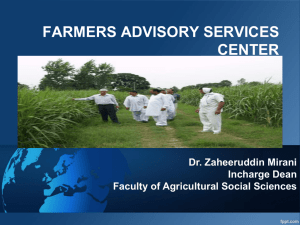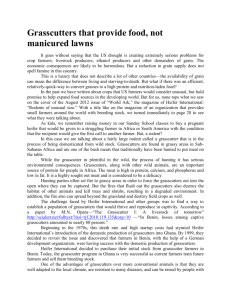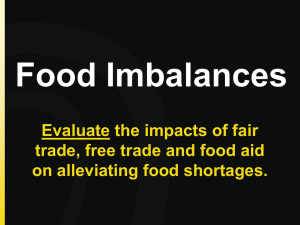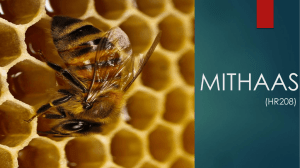USAID-Sub-Brand Powerpoint Template
advertisement
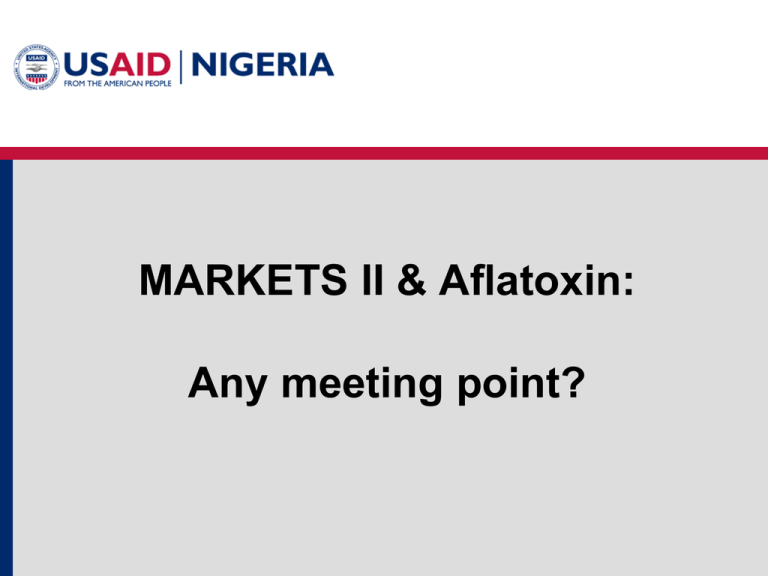
MARKETS II & Aflatoxin: Any meeting point? Project Background MARKETS II – Maximizing Agricultural Revenue and Key Enterprises in Targeted Sites II Follow-on to the erstwhile MARKETS project: 2005 – 2010 & and Bridge to MARKETS II: December 2010 to April 2011 MARKETS II 2012 – 2017 MARKETS I Legacy and Approach Project Background (2) Designed to strengthen: Agricultural competitiveness and food security in Nigeria by improving livelihoods in selected areas through improving productivity, increasing value addition, .increasing commercialization of selected commodities and processed products, and improving policy environment Commodities Rice Cassava Sorghum Sesame Cocoa Maize Cowpea Aquaculture Dairy Objective Increase private-sector participation and investment, raise incomes, increase employment, promote food security and reduce poverty MARKETS Activities • Training farmers to increase productivity and income through the application of best agronomic practices and increasing farmers' access to quality seeds, fertilizer and CPPs. • Providing farmers access to credit and other inputs • Brokering partnerships • Linking farmers to guaranteed markets • Promoting value-added processing Our Approach: USAID MARKETS signs agreement with BOA to provide credit at 8% to farmers May - July Last season, MARKETS Farmers increased yields from 1 MT per hectare to an average of 2.1 MT per hectare. Average net income increased to 46,750 Naira August - September October January Malted sorghum replaces imported barley. Aba Malting Plant Capacity: at least 60,000 MT February - May MARKETS Partner Da-Allgreen Seeds provides seeds, advice to farmers, transportation and logistics, limited credit and delivery to the Aba Malting Plant Partners: Rice Processing Farmer Cooperatives First Bank of Nigeria Nigerian Agricultural Insurance Corporation ADP / Benue State Government Olam Nigeria Limited Achievements of MARKETS I: Yield / Ha as a Proxy for Production Competitiveness 7.00 Average Yield per Hectare 6.00 5.00 4.00 3.00 2.00 1.00 0.00 Global Average Regional Avg (Rest of ECOWAS) Nigeria MARKETS Rice Farmers (All States) 1981-90 4.72 1.49 2.08 1991-00 5.49 1.60 1.69 2001-05 5.79 1.94 1.38 1.50 2006 6.03 1.81 1.44 3.16 2007 6.18 1.83 1.43 5.00 2008 6.18 1.86 1.42 5.20 Farmer benefits go beyond increased yields. By growing high-yielding, market-driven varieties, farmers generate greater profit margins due to the increased quantity and improved prices for high-quality paddy. 2009 6.32 1.88 1.41 5.20 Achievements of MARKETS I (cont): Beneficiaries Reached 1,169,430 People Trained in Agricultural Productivity 205,030 Gross Revenue Generated By Clients $ 260 M $ 364.2 M Credit leveraged $ 57 M 76.5MM $$76.5 People adopting new technologies or management practices 545,952 590,000 So, what have all these got to do with Aflatoxin? Maize and Groundnuts are the most susceptible crops to Aflatoxin Maize is one of MARKETS mandated commodities to support the fish feed and poultry industry. Networked farmers are assisted to grow the crop and supply our partner organizations for industrial uses. Nigeria produces about 8 million metric tons of maize annually out of which about ½ is stored Facts: We have noted that Mycotoxins: a) develop during production and harvesting or storage of agric produce b) occur more frequently under tropical and sub-tropical conditions c) are very stable, resisting high temperatures and several manufacturing processes d) affect agric productivity, human and animal health as well as international trade e) cannot be eliminated BUT controlled Control measures Train farmers to apply the following: 1) Dry grains as soon as possible after harvesting 2) Reduce breakage of grain to avoid contamination 3) Ensure silo conditions are oxygen free 4) Use crop rotation to avoid carry-over of moulds 5) Use resistant varieties 6) Encourage grain handlers to use masks to avoid inhalation Institutional collaboration Initiate dialogue on how to incorporate the above listed control measures and more into Extension and farmer training curricula in the relevant value chains Let’s dry properly





